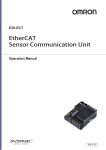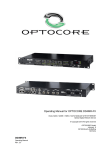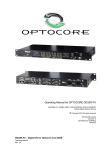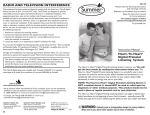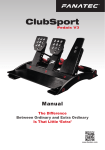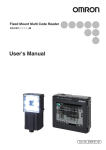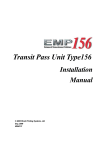Download 11M AP User Manual
Transcript
11M WLAN Access Point FreePort Station User’ s Manual Rev 1.0 FreePort Station User's Manual Using this Manual This section explains the symbols used in this manual. n Symbols Caution : Items to which you must pay attention when handling the product. Failure to follow this mark may result in personal injury and/or damage to the equipment. Note : Supplementary information that you should know when handling the product. Reference : Refers to the page of related subject. Next : Advises to which page you should continue next. Column : Explanatory text with this mark explains convenient facts for you to know. n Glossary and Diacritical Marks Within the Text Ÿ Text in bold indicates the names of menu options, buttons, text boxes, check boxes, software, and dialog boxes, etc., that you can select to perform operations. Ÿ The AP is referred as Access Point through this manual. Ÿ The personal computer to be used with the wireless LAN card is called the wireless LAN personal computer. Ÿ The personal computer to be used with the Access Point settings is referred as the Settings Personal Computer. 2 FreePort Station User's Manual Communication between a wireless LAN and a wired LAN This section describes how to use an AP when communicating between a wireless LAN and a wired LAN. Network Configuration Illustration Current Network Environment : Wired LAN Network Desired Network : Network comprising wireless and wired LAN PCs. 3 FreePort Station User's Manual Table of Contents 1. Communications Between Ethernet LAN and Wireless LAN Installation 2. Preparing the FreePort Station Settings 5 5 6 TCP/IP Protocol Setting 6 On Windows 98 / 95 6 Adding TCP/IP Protocols (Windows 98/95) 7 On Windows 2000 9 Adding TCP/IP Protocols (Windows 2000) 11 On Windows NT4.0 12 3. Installing FreePort Station Manager 13 Displaying FreePort Station Setting Screen 14 Enabling and Disabling Roaming Function 15 Limiting Connections from Wireless LAN PCs 16 Ensuring Security by the WEP (Encryption) Function 18 Grouping Multiple FreePort Stations 19 Configuring the Transmission Mode 20 Reset FreePort Station Settings to the Factory Defaults 20 4. Self-Diagnostic 21 5. Setting Screen Tables 22 6. Glossary 25 7. Product Specifications 28 Specifications 28 LAN Port Connector Specifications 29 4 FreePort Station User's Manual 1. Communications Between Ethernet LAN and Wireless LAN This section explains the procedure for enabling communication between personal computers on an Ethernet LAN and personal computers on a wireless LAN using AP. Installation Connection to the AP, hub, ground wire, and Power supply is shown below. Be sure to use the supplied AC adapter power supply. 5 FreePort Station User's Manual 2. Preparing the FreePort Station Settings (on the Personal Computer) The AP settings are preformed using a personal computer on the Ethernet LAN. For the proper AP setting, make sure that the following software are installed in the personal computer (hereafter called the settings personal computer) on the Ethernet LAN. TCP/IP protocol ……………………. . Refer to the “TCP/IP Protocol Setting” section below. FreePort Station Manager ………… Refer to “Installing the FreePort Station Manager”. Web browser (Microsoft Internet Explorer version 4.0 or later, or Netscape Navigator 3.0 or later): ……………………………………. . Refer to the relevant Web browser manual. Microsoft Internet Explorer is installed as standard on Windows 98 and Windows 2000. TCP/IP Protocol Setting The procedure for setting the proper TCP/IP protocol is depending on the OS used in the PC. Please refer to the following for the proper settings. Before the setting, check the LAN port drivers are properly installed in the personal computer and it is connected to the network. Windows 98/95: Windows 2000: Windows NT 4.0: Refer to “On Windows 98/95” below. Refer to “On Windows 2000”. Refer to “On Windows NT 4.0”. On Windows 98/95 The TCP/IP protocol is set as follows. 1. Start your personal computer. 2. Click the Start button, and then select Settings, and then Control Panel. 3. Double-click the Network icon. 4. In the Network dialog box, check that TCP/IP is displayed in the following network components are installed: Only 1 LAN board installed The dial-up adapter and the LAN boards are installed. TCP/IP (LAN board driver name) is normally displayed in the following network components are installed: [TCP/IP-> "LAN board driver name"] If no TCP/IP is displayed. Refer to “Adding TCP/IP Protocos (Windows 98/95)” section. 6 FreePort Station User's Manual 5 Select "TCP/IP" and click the Properties button. 6 Click the IP Address tab, set the IP Address and click OK Consult your network administrator for IP address settings for the configuration PC. If there is a DHCP server in your network, select "Automatic IP address assignment". 7 Restart Windows 98/95. This completes the configuration of the TCP/IP protocol for the configuration PC. Go to "Installing FreePort Station Manager" section. Adding TCP/IP Protocols (Windows 98/95) If the TCP/IP Protocol is not in added to the settings personal computer, add the protocol using the following procedure. 1 Click the Start button, and select Settings, Control Panel, and then Network. 2 Click the Add button. 7 FreePort Station User's Manual 3 Select Protocol, and click the Add button. 4 In the Manufacturers field, select Microsoft, and in the Network Protocols field, select TCP/IP and click the OK button. 5 The TCP/IP protocol is added. This completes the TCP/IP protocol installation. Continue to the “TCP/IP Protocol Settings” (On Windows 98/95) section procedure. On Windows 2000 The TCP/IP protocol is set on the settings personal computer using the following procedure. 1 Start Windows 2000, and log on using your logon name (e.g., Administrator with administrator access). 2 Click the Start button. Then select Settings and Network and Dial-up Connections. 3 Double-click the Local Area Connection icon. 4 Click the Properties button. 8 FreePort Station User's Manual 5 Check it Internet Protocol (TCP/IP) is displayed. If Internet Protocol (TCP/IP) is not displayed, refer to "Adding the TCP/IP Protocols (Windows 2000)" section. 6 Select Internet Protocol (TCP/IP), and click the Properties button. Con 7 Set the IP address, and click the OK button. If there is a DHCP server on the network, select "Obtain an IP address automatically". 8 Click the Close button. 9 FreePort Station User's Manual 9 Click the Close button. Go to “Installing FreePort Station Manager” section. Adding the TCP/IP Protocols (Windows 2000) If the TCP/IP Protocol is not in added to the settings personal computer, add the protocol using the following procedure. 1 Click the Start button, and then select Settings and Network and Dial-up Connections. 2 Double-click the Local Area Connection icon. 3 Click the Properties button. 4 Click the Install button. 10 FreePort Station User's Manual 5 Select Protocol, and click the Add button. 6 Select Internet Protocol (TCP/IP), and click the OK button. 7 Check if the Internet Protocol (TCP/IP) is added.Continue to next page This completes the TCP/IP protocol installation. Continue to the “TCP/IP Protocol Settings” (On Windows 2000) section procedures. On Windows NT4.0 Follow the steps below to set the TCP/IP protocol for the configuration PC. 1 Start the PC. 2 Click Start and select Settings and then Control Panel. 3 Double-click the Network icon. 11 FreePort Station User's Manual 4 Click the Protocol tab and check that "TCP/IP Protocol" is listed in the Network Protocol field. 5 Select "TCP/IP Protocol" and click Properties. 6 Type in the IP addresses and click OK. Consult your network administrator for the IP address settings for the configuration PC. When there is a DHCP server in your network, select "Automatic IP address assignment". 7 Restart Windows NT4.0. This completes the configuration of the TCP/IP protocol for the configuration PC. Go to "Installing FreePort Station Manager" section. 12 FreePort Station User's Manual 3. Installing FreePort Station Manager Install the FreePort Station Manager in the settings personal computer using the following procedure. 1 Insert the Driver CD in the CD-ROM drive. 2 Click the Start button, and select Run... 3 Enter D:\AP\SETUP.EXE (where D is the CD-ROM drive), and click the OK button. 4 Click the Next button. 5 Select the directory in which you want to install FreePort Station Manager, and click the Next button. To change the default installation directory, select a new directory, and then click the Next button. 6 Check the installation directory displayed, and then click the Start button. Windows will copy the file to the directory. 7 Click the OK button. Installation of the FreePort Station Manager is completed. To remove FreePort Station Manager, click the Start button, and select Programs, FreePort Station, and Uninstall FreePort Manager, and then follow the instruction on screen. 13 FreePort Station User's Manual Display FreePort Setting Screen Follow the steps below to display the FreePort Station setting screen. 1 Refer to " Installing FreePort Station Manager" to install the FreePort Station Manager. 2 Click Start and select Programs, FreePort Station and then FreePort Station Manager 3 Click Edit and select Search FreePort Station. 4 The computer starts searching for the FreePort Station. 5 6 The FreePort Station appears in the list. Select the FreePort Station, click Admin and select Configure AS. 7 The Web browser starts to display the FreePort Station settings screen. 14 FreePort Station User's Manual Enabling / Disabling the Roaming Function With the roaming function, an appropriate FreePort Station is automatically chosen according to the location of your PC. There is no need to change the FreePort Station’ s settings when you move your PC to another room. Follow the steps below to set the roaming function. 1 Refer to " Installing FreePort Station Manager" to install the FreePort Station Manager. 2 Click Custom Setting. 3 Fill in the following fields. Group Name: All FreePort Stations that are set up for roaming must have the same Group Name. Roaming option: "Use" After filling in the fields, click Set. Follow the screen prompt. 15 FreePort Station User's Manual Limiting connection from Wireless LAN PCs Follow the steps below to limit the connection capability from wireless LAN PCs to the FreePort Station. The steps below will change settings so that no wireless LAN PCs other than those registered with the settings can connect to the wired LAN PCs. Setting procedure 1 Refer to " Installing FreePort Station Manager" to install the FreePort Station Manager. 2 Click Custom Setting. 3 Click "Wireless LAN Computer Limitation". 4 Select "Set Limit" for Wireless LAN Computer Limitation Setting and click Set. 5 When the message "Settings Complete" appears, click "Return". 16 FreePort Station User's Manual 6 Type in a MAC address for the wireless LAN PC to be connected to the wired LAN PCs in the "Wireless LAN Computer MAC Address" field and click Add. • Refer to the manual supplied with the wireless LAN PC for information about the MAC address. • The MAC address should be separated every two digits by colons ( : ). When the "Unavailable wireless LAN computer(s)" list includes a wireless LAN card which you want allow to connect to the Wired LAN PCs, tick the "Enable" check box for the relevant MAC address and click Change. 7 When the message "MAC addresses added" appears, click Return. 8 The added MAC address will appear in the "Available Wireless LAN Computer(s)" field. Up to 256 MAC addresses can be registered. No wireless LAN PCs other than those registered in the "Available Wireless LAN Computers" field can communicate with any wired LAN PCs. Communication between wireless LAN PCs via the FreePort Station is available. To disable a registered wireless PC, tick the "Disable" check box for the relevant MAC address in the "Available Wireless LAN Computers" field and click Change. 17 FreePort Station User's Manual Ensuring Security by the WEP (Encryption) Function Follow the steps below to encrypt wireless packets so that they cannot be intercepted by a third party. If the WEP function is set, communication between a Macintosh computer is not available. Setting procedure 1 Refer to " Installing FreePort Station Manager" to install the FreePort Station Manager. 2 Click Custom Setting. 3 Enter a 5-digit encryption key in the "WEP (encryption code)" box. Enter the same encryption key again in the "Confirm Encryption Code" box for confirmation and click Settings. The five characters can include alphanumeric characters and an under bar "_" . 4 When the message "Setting Complete" appears, close the browser. 18 FreePort Station User's Manual Grouping Multiple FreePort Stations If there are many FreePort Stations in the same area each having wireless LAN PCs connected, the overall data transmission speed may slowdown considerably. This could be the result of all the FreePort Stations using the same frequency radio wave. Assigning a different frequency (wireless channel) to each wireless LAN will improve the transmission speed. Follow the steps below to change wireless channel and differentiate the LANs. Setting procedure 1 Refer to " Installing FreePort Station Manager" to install the FreePort Station Manager. 2 Click Custom Setting. 3 Choose a wireless channel in the "Wireless Channel" box to assign it to the FreePort Station and click Set. 4 When the message "Setting Complete" appears, close the browser. • Using close frequencies (channels) may cause interference. When using two or more channels, each channel should be spaced by two or three channels. (Changing the wireless channel may cause interference with other radio wave equipment.) 19 FreePort Station User's Manual Configuring the Transmission Mode Follow the steps below to configure the transmission mode. 1 Refer to " Installing FreePort Station Manager" to install the FreePort Station Manager. 2 Click Custom Setting. 3 In the "Communication Mode" field, select either Full Duplex or Half Duplex and click OK. When the FreePort Station is set at Full Duplex, make sure that the hub is also set at Full Duplex. When the FreePort Station is set at Full Duplex Mode and the hub is set at Half Duplex or at Auto Detection, they cannot communicate with each other. Resetting FreePort Station Settings to Factory Defaults 1 Power on the FreePort Station. 2 Hold down the "RESET" button located at the rear of the FreePort Station for 3 seconds or longer to reset the FreePort Station to the factory default settings. 20 FreePort Station User's Manual 4. Self-Diagnostic The FreePort Station performs self-diagnosis every time it is turned on or restarted. When an error occurs, the "DIAG" lamp flashes a specific number of times identifying the error. The lamp flashing pattern is repeated until the FreePort Station is restarted or turned off. DIAG lamp Error Descriptions Number of flashes Error Explanation 1 RAM check error Cannot read/write the internal memory. 2 ROM check error Cannot read/write the flash ROM. 3 Wired LAN error Wired LAN controller malfunction. 4 Wireless LAN error Wireless LAN controller malfunction. 5 Clock error The clock is not set correctly, or the clock battery may be depleted. 9 Other errors 3 If one of the above errors is displayed, try removing the AC adapter from the socket to restart. 21 FreePort Station User's Manual 5. Setting Screens Tables This section explains details of the setting screen tables. Setting Screen Configuration 22 FreePort Station User's Manual Setting Screens Explanation Items marked with an asterisk (*) can be set using the Standard Setup screen. Detailed Settings (Bridge Mode) Note 1: Enter a maximum of 32 alphanumeric characters (case sensitive), and the underbar "_". Note 2: Enter a maximum of 16 alphanumeric characters (case sensitive), and the underbar "_". Note 3: Enter a maximum of 5 alphanumeric characters (case sensitive), and the underbar "_". 23 FreePort Station User's Manual Machine Diagnostics 24 FreePort Station User's Manual 6. Glossary This section explains the glossary of terms used in this manual that are required to configure the network. Wireless Channel If there is more than one Wireless LAN network with different ESS-ID on the same floor, and they are communicating with each other, the baud rate may be slowed, due to the same radio frequency being used. If this happens, you can still communicate regardless of other LAN networks by using to use different frequencies (wireless channels). Note: If they are communications using the wireless LAN, be sure to set all the Units the same wireless channel. DHCP Server When configuring the network TCP/IP, be sure to set the IP address in each personal computer and other devices. When there is a DHCP server on the network, you can assign IP addresses automatically to the personal computers and the FreePort Station on the network. If there is Windows 2000, Windows NT, dial-up router, or other device with built-in DHCP server function on the network, the DHCP server function may start to operate. For the Windows NT server and dial-up router, or other DHCP server function, refer to the Windows 2000, Windows NT, or dial-up router manual, or consult the manufacturer. There should be no DHCP server problems for Windows 98/95 personal computers only on the network. ESS-ID This ID is used to prevent cross-communication during communication between the FreePort Station and personal computers within the wireless LAN. The Wireless LAN personal computers that have the same ESS-ID as the FreePort Station can communicate with the FreePort Station. (ESS-ID is disabled when wireless LAN personal computers are communicating each other.) Set the FreePort Station ESS-ID as follows: Last six digits of MAC address + Group name. The ESS-ID is case sensitive. You can enter a maximum of 32 alphanumeric characters, and the underbar "_". LAN (Local Area Network) Read as one word. A LAN is a network in a comparatively small area, such as campus or within a single building. The LAN baud rate varies from 10 Mbps to 100 Mbps. MAC Address (Media Access Control Address) The MAC address is a physical address specific to each network card. The MAC address is configured from a total of six bytes as follows: A vendor code comprising the lead three bytes and a 3-byte user code. The vendor code is managed and assigned by IEEE. The user code is managed using a unique (unduplicated) number from the network card manufacturer. That is, the MAC address is assigned as a physical address unique throughout 25 FreePort Station User's Manual the world. In an Ethernet LAN, the MAC address is used as a base to create a frame for sending and receiving. TCP/IP (Transmission Control Protocol/Internet Protocol) TCP/IP is a protocol equivalent to the network and transport levels of the OSI reference model, and it is defined using RFC. Consequently, different terminals can communicate with each other using TCP/IP. • Normally, TCP/IP includes the application protocols TELNET and FTP. • TCP/IP is the standard internet protocol. WEP (Encryption) By setting an encryption key in the FreePort Station, you can prevent wireless packets from being decrypted externally. When connecting to the FreePort Station with the encryption key you must enter the encryption key from the FreePort manager. Windows 98/95 Identification Screen Displayed Screen Double-click the Network icon and click the "Identification" tab. The following screen will be displayed. Explanation of Screen Fields The boxes within the screen are as follows: Computer name: The name used to identify the computer on the network. Set a unique name for each personal computer. Workgroup: The name used to identify the computer workgroup on the network. If there is no particular need to identify separate workgroups, set the same workgroup name for all the personal computers on the network. Computer Description: Use this box to enter additional explanation of the computer name. You can also leave this box blank. Firmware Firmware is the name given to the software (programs) built into hardware such as the router, modem, and 26 FreePort Station User's Manual terminal adapter. This software is built into the hardware, so it can be said to be in-between hardware and software. Protocol Protocols are the procedures and regulations for sending and receiving data between the network terminals. For example, if two computers are communicating, you can send the correct information according to the regulations by formatting all required information. The protocol such as which terminal sends first, what type of message, what type of message the receiving terminal should send in reply, the data format, and responses to communications errors are same of examples. Roaming Function If using the roaming function and moving from one room to another room, you can switch the FreePort Station automatically. With the roaming function, you can easily move from the office to the conference room while maintaining access to the network. Ethernet LAN and Wireless LAN The following terms are used in this manual to clarify the distinction between the wired 10/100 base LAN, and the wireless LAN. Ethernet LAN: LAN connected using cables Wireless LAN: LAN that uses wireless communications The above terms are used for explanatory in this manual and they are not used generally. 27 FreePort Station User's Manual 7. Product Specifications This chapter describes the specifications of the product and the LAN port connector. 28 FreePort Station User's Manual LAN Port Connector Specifications The RJ-45 8-pole connector, specified ISO / IEC8877:1992. MDI Signal Assignment 29 FreePort Station User's Manual NOTICE The information in this manual is subject to change without notice. Federal Communications Commission Notice This equipment has been tested an found to comply with the limits for a Class B digital device, pursuant to Part 15 of the FCC Rules. These limits are designed to provide reasonable protection against harmful interference in a residental instration. This equipment generates, uses, and can radiate radio frequency energy and, if not installed and used in accordance with the instructions, may cause harmful interference to radio communications. However, there is no guarantee that interference will not occur in a particular installation. If this equipment does cause harmful interference to radio or television, which can be determined by turning the equipment off and on, the user is encouraged to try to correct the interference by one or more of the following measures: Ÿ Reorient or relocate the receiving antenna. Ÿ Increase the separation between the equipment and the receiver. Ÿ Connect the equipment into an outlet on a circuit different from that to which the receiver is connected. Ÿ Consult the dealer or an experienced radio/TV technician for help. 30






























